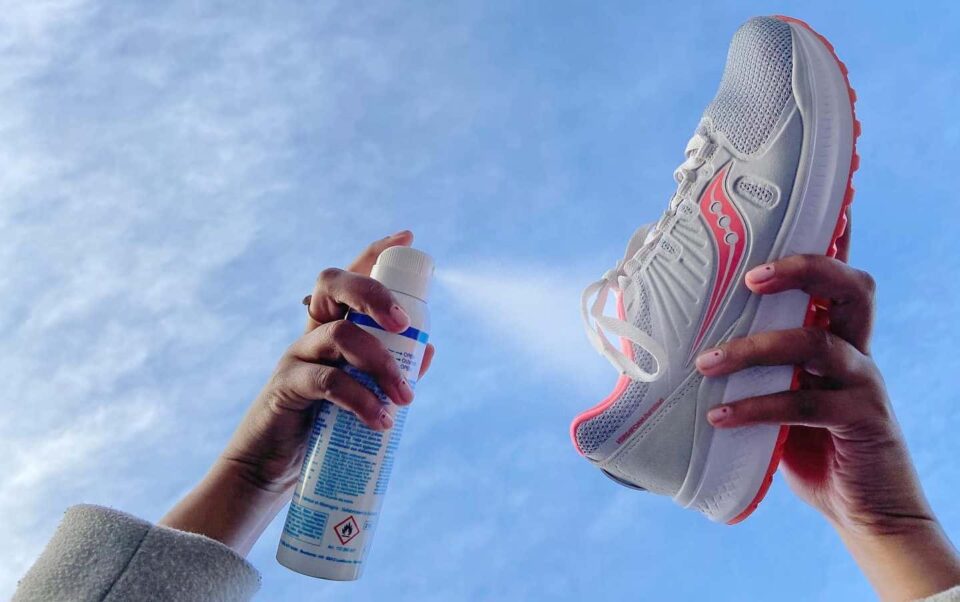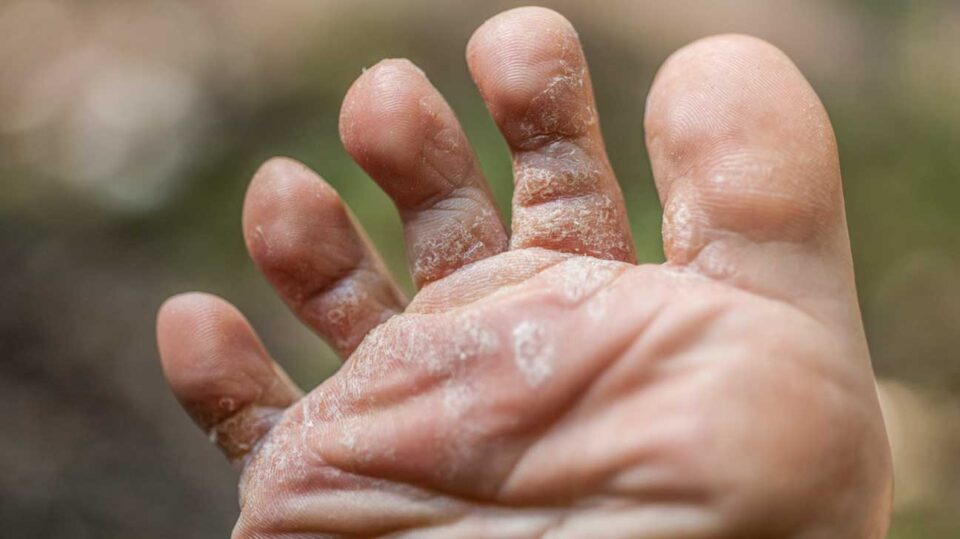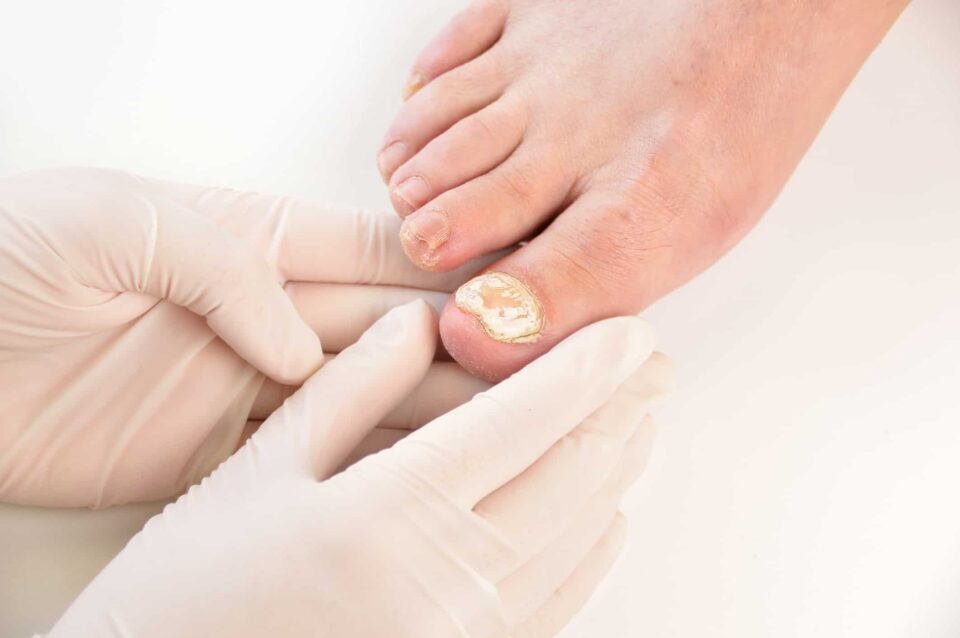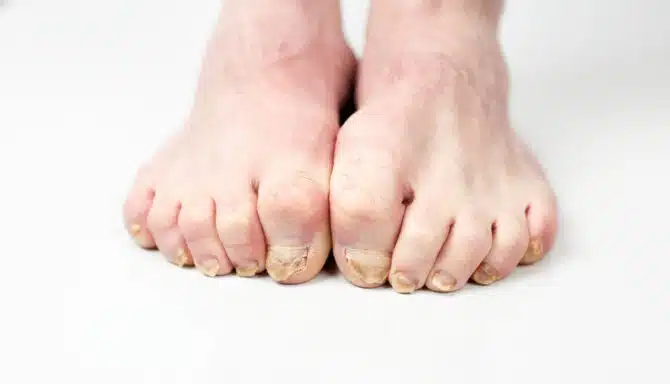November 7, 2024
Foot odor is a frustrating problem; it goes to show that non-painful foot conditions can be as life altering as painful ones. There are many foot odor myths floating around the internet. In this article, we'll break down some of the most common foot odor myths, and give you the facts about foot odor causes and how to prevent it.
6 Myths About Foot Odor:
Only People With Sweaty Feet Have Foot Odor
Foot Odor Always Means You Have a Serious Health Condition
All Foot Odor Smells the Same
Going Barefoot Helps Eliminate Odor
If You Have Foot Odor, you Aren’t Showering or Bathing
Foot Odor Only Happens in Hot Weather
Myth 1: Only People With Sweaty Feet Have Foot Odor
Foot odor, also known as bromodosis, is the unpleasant smell that comes from the feet due to a combination of sweat and bacteria. The feet have numerous sweat glands, which produce moisture to regulate temperature and prevent skin from drying out. Plantar hyperhidrosis is the medical term for excessively sweaty feet. Sweat is a major contributor to foot odor and provides the moisture needed for it to thrive, however, other factors are also at play.
The Main Causes of Foot Odor
General bacterial buildup and everyday life! (wearing shoes all day long, etc).
Fungal infections: Conditions like athlete’s foot can lead to odor as fungi produce waste products during growth.
Diet: Certain foods, like garlic and onions, can affect sweat composition and lead to a noticeable foot odor.
Health conditions: Conditions other than plantar hyperhidrosis can cause foot odor, including diabetes, particularly when ulcers and wounds omit a strong smell. Other conditions include thyroid disorders (they may cause excessive sweating) or kidney and liver issues.
Footwear material: Shoes made from non-breathable materials trap even normal sweat production, increasing moisture and bacterial growth. Preventing foot odor often means choosing breathable, waterproof shoes.
Hormonal changes: Puberty, pregnancy, or menopause can contribute to foot odor.
https://www.youtube.com/shorts/1aaNATnXvWw
Foot Odor Myth # 2: Foot Odor Always Means You Have a Serious Health Condition
It’s true that one of the causes of foot odor can be an underlying health condition, but that doesn't mean it's serious. The most common cause of foot odor is a general build up of sweat and bacteria that you can tackle yourself.
Foot odor is often caused by everyday factors like wearing shoes made from non-breathable materials or not changing socks frequently enough. In most cases, simple steps like improving hygiene, airing out shoes, or using foot deodorants (sprays, powders or creams) can help control the smell.
While it's important to be mindful of persistent odor or other accompanying symptoms, the vast majority of foot odor issues are easily managed with at-home care and do not indicate a serious health condition.
https://www.youtube.com/shorts/aFdZ042koME
Foot Odor Myth # 3: All Foot Odor Smells the Same
Foot odor can vary significantly based on several factors, including the underlying cause, personal hygiene, diet, and the type of bacteria or fungi present. For example, open wounds and sores will smell different than smelly, sweaty shoes. Here are some common smells:
Sour: Often caused by bacteria breaking down sweat, resulting in lactic acid production.
Musty: May be associated with fungal infections or warm, moist environments.
Vinegar-like: Often linked to sweat and potentially neglectful hygiene.
Ammonia: May indicate dehydration or a dietary imbalance.
Rotten: This odor can be a sign of a more serious infection.
Foot Odor Myth 4: Going Barefoot Helps Eliminate Odor
While going barefoot might seem like a good idea for reducing foot odor, it can actually have the opposite effect in some cases. While it’s always good to air out your feet, going barefoot outside exposes your feet to various surfaces that may harbour bacteria and fungi. Walking on dirty or damp surfaces can lead to the accumulation of these microorganisms, potentially worsening foot odor. In fact, foot fungus (one of the most common causes of foot odor) is often caused by walking barefoot in public places.
Additionally, sweat can still pool in the crevices of your feet without socks and shoes, allowing bacteria to thrive. Instead of eliminating odor, going barefoot may introduce new sources of smell. Wearing breathable footwear and moisture-wicking socks and changing them regularly is a much better idea.
Myth 5: If You Have Foot Odor, You Aren’t Showering or Bathing
This is completely untrue since foot odor is often linked to other conditions like plantar hyperhidrosis and fungal infections. Therefore, foot odor is is a symptom rather than a cause. It also often develops throughout the day, so you can shower every morning and still experience smelly feet when you get home at night.
That said, you should pay more attention to foot-specific hygiene and clean your feet frequently. Check out this blog article on foot hygiene tips to learn what to do.
Myth 6: Foot Odor Only Happens in Hot Weather
Foot odor is commonly associated with hot weather, but it can occur year-round, regardless of the temperature. While warm conditions can exacerbate sweating and create a breeding ground for bacteria, factors such as personal hygiene, footwear choice, and lifestyle also play significant roles in foot odor.
For example, wearing insulated shoes in fall or winter weather can trap moisture and heat, leading to odor even when temperatures are low. Additionally, individuals who sweat excessively—regardless of the season—are more likely to experience foot odor. Therefore, it’s essential to maintain proper foot care and hygiene practices throughout the year to prevent odor, not just during the warmer months.
https://youtube.com/shorts/meO8VW1yxJ4?si=EQb3gbihQ8E6-E0j
October 24, 2024
There are two common fungal infections that can target your feet. For your skin, it’s athlete’s foot (tinea pedis), and for your nails, it’s fungal toenail (onychomycosis). Fun fact: Onychomycosis is the name for nail anatomy changes caused by contagious fungus, while dystrophic is the term for any other abnormalities that affect how your nails look or grow. Today’s blog will focus solely on toenail fungus. You’ll learn what it is and how to treat it, as well as some top fungal toenail prevention tips recommended by our Toronto chiropodists.
Toenail Fungus Symptoms
Sometimes toenail fungus is mild and barely noticeable. But fungal toenail can present more severely if you’re immunocompromised, such as if you have diabetes, or a senior. Keep an eye out for these common symptoms:
Drastic changes in the nail’s appearance: it can look much thicker, have a yellowish, brown colour, and be very brittle and prone to cracks, despite thickening.
Unpleasant odour coming from the nail: the smell is often reported to be sour or like cheese.
The nail starts lifting off the nail bed: this is because debris starts to accumulate and lifts the nail up so it can’t reattach.
Pain, swelling and bleeding in severe cases.
Toenail Fungus Prevention: Foot Specialist Advice
The most important fact to remember about fungal toenail is that it’s contagious. Since fungal infections spread easily in damp, shared spaces like pools, gyms, and shower rooms, the best defense is keeping your feet clean and protected! Here are some top, Toronto-chiropodist-recommended tips to remember:
Follow a strict, yet fun and relaxing, foot hygiene routine. It’s a part of self care, after all!
Wear breathable footwear. Opt for shoes made from materials that allow airflow to keep your feet dry.
Change socks daily. Fresh socks prevent moisture buildup, which fungi love.
Avoid going barefoot in public places. Use flip-flops or shower shoes to protect your feet in shared spaces.
Keep your toenails trimmed and clean. Regular maintenance helps prevent infections from taking hold. Get a professional medical pedicure if you don’t have time to focus on nail care.
How to Treat Toenail Fungus
Once fungus has gotten a hold of your nails, it’s time to think about treatment and eradicating the problem. Unfortunately, you can’t do much to treat toenail fungus yourself at home, and you often need a chiropodist’s help. Luckily, treatments are easy to follow and non-invasive. Here’s what a foot specialist can do:
Perform nail debridement to remove infected parts of the nail.
Use prescription-strength topical antifungal medicine on the nail (it penetrates the actual fungus)
Educate you on products you can use going forward to prevent re-infection, like the best moisture-wicking socks, shoes, foot creams, deodorants and more.
October 10, 2024
Toronto's summer is behind us and the warm days of sandals won’t return until next year. But fall brings its own charm and many folks are excited for a new chapter. At the same time, you may also be looking to prevent foot issues this fall in as many ways as possible, and luckily, you’ve come to the right place! For top tips on blisters and dry skin prevention, as well as how you can fight some other common fall foot problems, keep reading today’s article!
Cracked Heels
As summer’s humid air is replaced with dryness, the skin on your feet may dehydrate and over time, cracked heels can form.
One of the best fall foot care tips to prevent this is regular moisturizing. Use a nutrient-dense product like Gehwol’s Lipidro Cream, available at Toronto’s Feet First Clinic.
It helps lock in moisture and prevent further damage. Containing high-quality ingredients like avocado oil and urea, this cream helps your skin absorb water into its layers and supplies dry skin with the lipids it needs. Properties like allantoin can also soothe irritation sometimes associated with cracked heels.
Fungal Infections
You may have heard how fungal infections like athlete’s foot are easy to contract during the summertime. Public pools, shared locker rooms and showers, and other communal spaces are all summer hot spots where this foot fungus can breed. But did you know that foot fungi is still a threat in the fall?
It can thrive when people wear closed shoes for longer periods, trapping moisture and warmth. To prevent this, keep feet clean and dry, wear breathable socks, and choose shoes that allow proper ventilation. Shoes should also be waterproof to prevent extra water getting into your shoe’s environment. To find the right pair for fall, visit your local Toronto foot clinic for a shoe fitting.
While you’re at it, learn all about the best foot hygiene here!
Musculoskeletal Foot Conditions
Musculoskeletal foot conditions can flare up as the fall chill starts to bite, making each step feel a little extra uncomfortable.
Cold temperatures cause the tissues in your joints to contract, putting pressure on nerve endings and leading to more foot pain and aggravated osteoarthritis. The cold can also worsen foot conditions like plantar fasciitis and other sources of arch and heel pain.
Get ahead of this issue by wearing boots with solid insulation that traps warmth. Also, keep your feet extra cozy with warm socks — a Toronto chiropodist may even suggest a pair of compression stockings (like Sigvaris' Thermoregulating Wool or Merino Wool compression stockings).
Blisters
Autumn foot health often involves managing painful blisters. As new footwear makes its debut, a tight squeeze can slowly wreak havoc and cause discomfort.
To keep your feet happy and blisters at bay, make sure your shoes fit securely and snugly (but not tight!) to prevent excessive friction rubbing against your skin. Wear your boots with other products like moisture control socks, foot powders, blister bandages and insoles to prevent this frustrating issue.
September 5, 2024
Athlete's foot is a fungus that infects the skin on your feet. Many people get it, and it can cause a lot of problems. Your feet may itch, turn red, and peel when you have it. This fungus grows best in places that are warm and damp. The good news is that you can treat and stop athlete's foot if you know what to do. Here are some tips from chiropodists (foot specialists) to help you keep your feet healthy and free from fungus.
Treatment strategies
See a Chiropodist
Because of all the moisture buildup on our feet, fungal infections can grow out of control very quickly; they're stubborn and persistent, and once the infection gets under the toenail, it becomes very difficult to treat. In addition, over-the-counter anti-fungal medications are not very effective unless the infection is in the very early stages. That's why it's important to see a chiropodist as soon as you notice any symptoms. A chiropodist will debride and clean up any fungal growth on the skin and prescribe a topical anti-fungal medication to help nip the athlete's foot in the bud before it spreads to the toenails. Oral anti-fungal medications, while effective, are often not recommended due to their side effects. Often, topical prescription anti-fungal medication and persistence are the best way to go.
Maintain a rigid hygiene routine
Your feet and body will thank you if you keep the infected area clean and dry. Wash your feet daily with soap and water and dry them well between your toes. Fungus grows best in damp places, so ensure your feet are dry before putting on socks and shoes. If you're particularly prone to sweaty feet, you can also try an anti-bacterial foot deodorant like Gehwol's Foot Deodorant spray. This can help prevent Athlete's foot, and even treat it in its very early stages.
Avoid scratching
Scratching the infected spot can cause other bacterial infections. To soothe the itch, try using antifungal creams or powders. If the infection gets worse or spreads, talk to a doctor.
Change socks regularly
Choose cotton or merino wool socks that let your feet breathe and wick away sweat. Wear fresh socks every day and change them after physical activity or when they get wet. This helps reduce moisture build-up, which can worsen the fungal infection.
Prevention Tips
Avoid walking barefoot in public
Athlete's foot, along with other fungal infections, are contagious and spread when skin comes into contact with an infected surface. Therefore, always make sure you are wearing some kind of protective footwear in public spaces - like flip flops or slippers - in locker rooms, communal showers, pool decks and gymnasiums.
Stick to a foot care routine
Clean your feet and dry them well between your toes. Also make sure you cut and clean your toenails often, as fungi can hide under the toenails. Just make sure you don't cut them too short, or you can get an ingrown toenail.
Put on the right shoes
Pick shoes that let air flow through them. Avoid (if possible) wearing the same shoes all day, every day, and ensure they're dry before putting them on. Use flip-flops or water-safe sandals in public spots like pools or gym showers to avoid touching infected surfaces.
Clean Your Shoes
Fungal spores can hang around in shoes, which will feed the infection. To combat this, spray your shoes and socks with antifungal and antibacterial products, such as hypochlorous acid, zinc oxide or zinc incoleate, and dry them out before you put them on again.
You can use Gehwol Foot & Shoe Deodorant Spray in your shoes, or dust Gehwol Foot Powder into your socks. These products contain zinc oxide and zinc ricinoleate, respectively, which are great for maintaining a healthy environment in your shoes. You can find these products at our Toronto foot clinic.
Keep personal items to yourself
Don't let others use your towels, socks, or shoes, and vice versa. Fungal infections are contagious and spread through touching or sharing personal items with people who have a fungal infection.
June 24, 2024
Oh no, yellow feet! This seemingly alarming skin pigmentation is not usually cause for concern and is far more common than you think. Yellow feet commonly present as yellow bottoms of the feet and are usually not an immediate emergency. That said, they should be looked at during a foot assessment as there may be underlying medical causes or dermatological conditions at play. Let’s review the top culprits for yellow skin on the bottom of your feet.
Calluses and Corns
If the yellow skin on your feet feels hard to the touch and only occurs in certain spots (the whole foot isn’t yellow), you probably just have a lot of thick calluses!
Imagine your feet are like well-trodden paths; the more you walk on them without protective footwear, the thicker and tougher they become, forming “callused armour” which often has a yellow hue.
One of the most well-known podiatric concerns, calluses can be treated if they become a problem for hygienic reasons and also to prevent them from becoming more painful, infected or ruining your skin’s integrity and strength.
Corns can also cause thick, yellow skin.
Calluses and corns can be easily removed by a chiropodist using sterilized, medical-grade equipment. Read more about how our chiropodists treat calluses.
Hyperkeratosis
A dermatological condition called hyperkeratosis causes excessive hard and yellow calluses that can cover the majority of the bottom of your foot. When combined like this they can be a lot worse than solitary calluses and are more likely to crack, bleed, and hurt.
Carotenemia
You are what you eat! And in this case, you may be eating too many carotene-rich foods (like carrots, sweet potatoes, pumpkins — anything orange!) if the entire bottom of your foot has a mild, yellow hue. The good news? This is harmless.
While noticing this effect on the bottom of the feet can be disconcerting, it may also occur on your face, which might have a positive effect on your confidence. Studies show these mild, facial skin changes can contribute to the overall appearance of health and vitality in humans. Pretty cool!
Jaundice
Jaundice is a serious occurrence that points to a poorly functioning liver, gallbladder or pancreas. Your doctor will help you determine the root cause.
A tell-tale sign that you’re experiencing jaundice is if the yellow colour is quite strong, and if the whites of your eyes are also yellow (sclera).
If you don’t have any other symptoms outside of mildly yellow feet, it’s unlikely you have jaundice, but it’s better to be safe than sorry!
Fungal Infections
Athlete’s foot causes flaky and itchy skin clusters around your toes and the ball of the foot. They look red or pink when irritated, but sometimes turn whitish yellow. Don’t try to treat this at home - you might damage your skin and nail health. Seek guidance from your local Toronto foot clinic instead! They can point you towards the right ointments, creams and other treatments. Learn more about treatment and prevention.
Anemia
This medical condition affects your red blood cells and impairs oxygen flow throughout your body. The entire foot or entire bottom of the foot will have a bright, yet mild, yellow tint. If your feet are cold to the touch in addition to being yellow, you might have anemia.
April 22, 2024
When it comes to anti-aging routines, our feet are often overlooked. Yet, they are one of the hardest-working parts of our body and deserve just as much attention as our skincare regimen.
As we age, our feet undergo natural changes that can lead to discomfort and mobility issues if left unchecked. In this blog post, we'll explore age-defying foot care tips to help keep your feet feeling youthful and vibrant at any age.
1. Maintain proper hygiene
Good foot hygiene is the foundation of age-defying foot care. As we age, our skin becomes thinner and more susceptible to infections, making it essential to keep our feet clean and dry to prevent fungal infections and bacterial growth. Have regular bathing/ showering, paying close attention to the spaces between toes, and thoroughly dry them afterward to prevent moisture buildup.
2. Moisturize regularly
Dry, cracked skin is a common issue that affects aging feet. To keep your feet soft and supple:
Moisturize them regularly with a rich foot cream or lotion. But not between the toes.
Focus on areas prone to dryness, such as the heels and soles, and consider using products containing ingredients like urea or shea butter, known for their hydrating properties.
For an extra treat, indulge in a weekly foot soak followed by a moisturizing foot mask to pamper your feet and lock in moisture.
3. Supportive footwear
As we age, the fat pads in our feet naturally thin out, leading to decreased cushioning and shock absorption—this is known as fat pad atrophy. Investing in supportive footwear with ample cushioning and arch support is crucial for maintaining foot health and preventing discomfort. Look for shoes with a roomy toe box to accommodate any changes in foot shape. Opt for styles with adjustable straps or laces for a customized fit. Additionally, consider wearing orthotic inserts or custom-made orthotics to provide extra support and cushioning.
4. Consistent exercise
Like the rest of our body, our feet benefit from regular exercise to improve strength, flexibility, and circulation. To keep your feet limber and mobile, incorporate simple foot exercises into your daily routine, such as toe curls, ankle circles, and calf stretches. Additionally, consider practising yoga or tai chi, which can help improve balance and stability, reducing the risk of falls and injuries as we age.
5. Routine and regular check-ups
Regular foot exams are essential for detecting foot problems or underlying health issues early. Schedule regular check-ups with a chiropodist or foot specialist to monitor your feet's health and address any concerns promptly. They can provide valuable insights and recommendations tailored to your needs, helping you maintain healthy, youthful feet for years.









